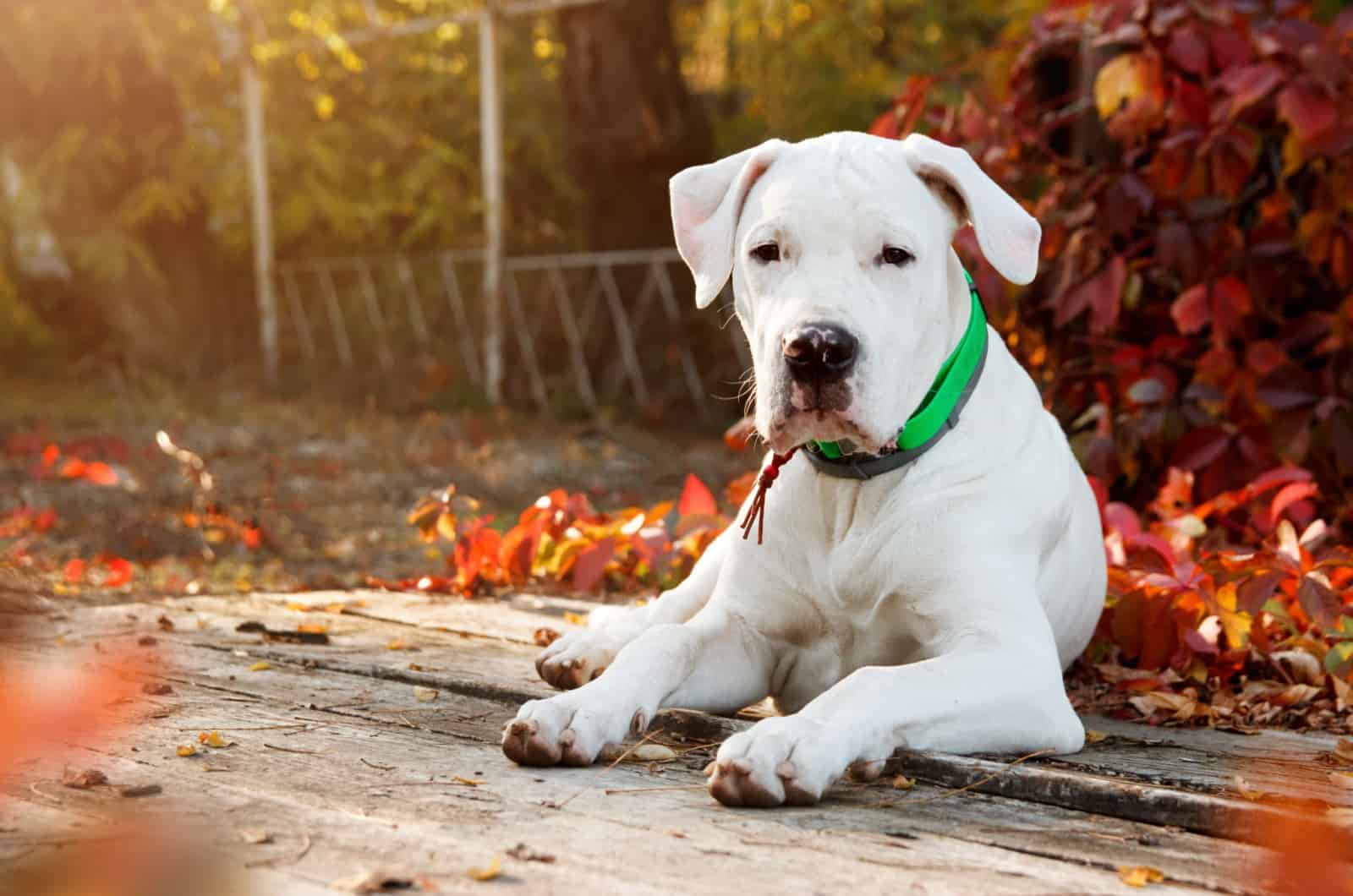The Dogo Argentino is an absolute giant of a dog, one that does require a lot of nutrition. This absolute beast can grow pretty big, but how does he get exactly? Find out with the Dogo Argentino growth chart.
The Dogo Argentino Growth Chart will help display how your dog’s weight and height develop throughout his entire lifespan; from his puppy years, to adulthood and finally his senior years.
These growth and weight charts are usually built to be more like guidelines than the main source of information that we base diets for our pets on due to the varying ranges that so many dogs fall under.
Many different factors influence this, be it genes, diet or levels of exercise, among other things, so it’s natural that every dog is going to end up having a different threshold for each of these measurements and a different diet.
Their lifestyles adapt to the environment, and thus the best way to look at a growth chart for any dog breed is to use it merely as a foundation on which to build on your own precious pooch’s ideal diet to allow him to live a long and healthy life.
To get a more precise idea on what your dog’s diet is supposed to look like and to figure out whether or not he’s developing properly, consult your local vet as he has access to more intimate information about your dog and can present more specialized options.
So, read on to find out what this growth and weight chart looks like, how a Dogo Argentino develops throughout the years as well as the various things that affect this process, and many other questions related to the topic at hand.
The Dogo Argentino Growth Chart
[table id=638 /]
As you can see here, the Dogo Argentino puppy goes through a rather rapid growth process early on in terms of weight, gaining about 10 to 11 pounds per month until about month 6 at which point it starts to steadily decrease.
His height behaves similarly too, going through massive growth spurts when he’s around 6 to 8 months of age and then having them decrease in intensity just as much.
It comes as no surprise however, especially considering that these gargantuan dogs usually grow to be about 27 inches in height and nearly 100 pounds weight wise as far as the adult male Dogo Argentino is Concerned.
For adult female Dogo Argentino, they’re a bit smaller, capping out at around 26 inches and 95 pounds, give or take a few pounds for both of them.
Not that big of a difference and one that may be harder to notice live, but female Dogo Argentino will appear ever so slightly skinnier than their male counterparts.
Anything after the 12 month mark becomes relatively miniscule in terms of gain, but it does take another 4 to 6 months after that for your dog to reach physical maturity and reach his adulthood.
However, not much will change there either as anything past the puppy stage mostly feels like maintenance mode since there won’t be any further drastic shifts in diet or lifestyle aside from serious illness or other health problems.
His senior years will equate to about the same, though you will have to be on the lookout for any potential issues regarding his bones and joints, among other things.
Dogo Argentino Growth Throughout The Years
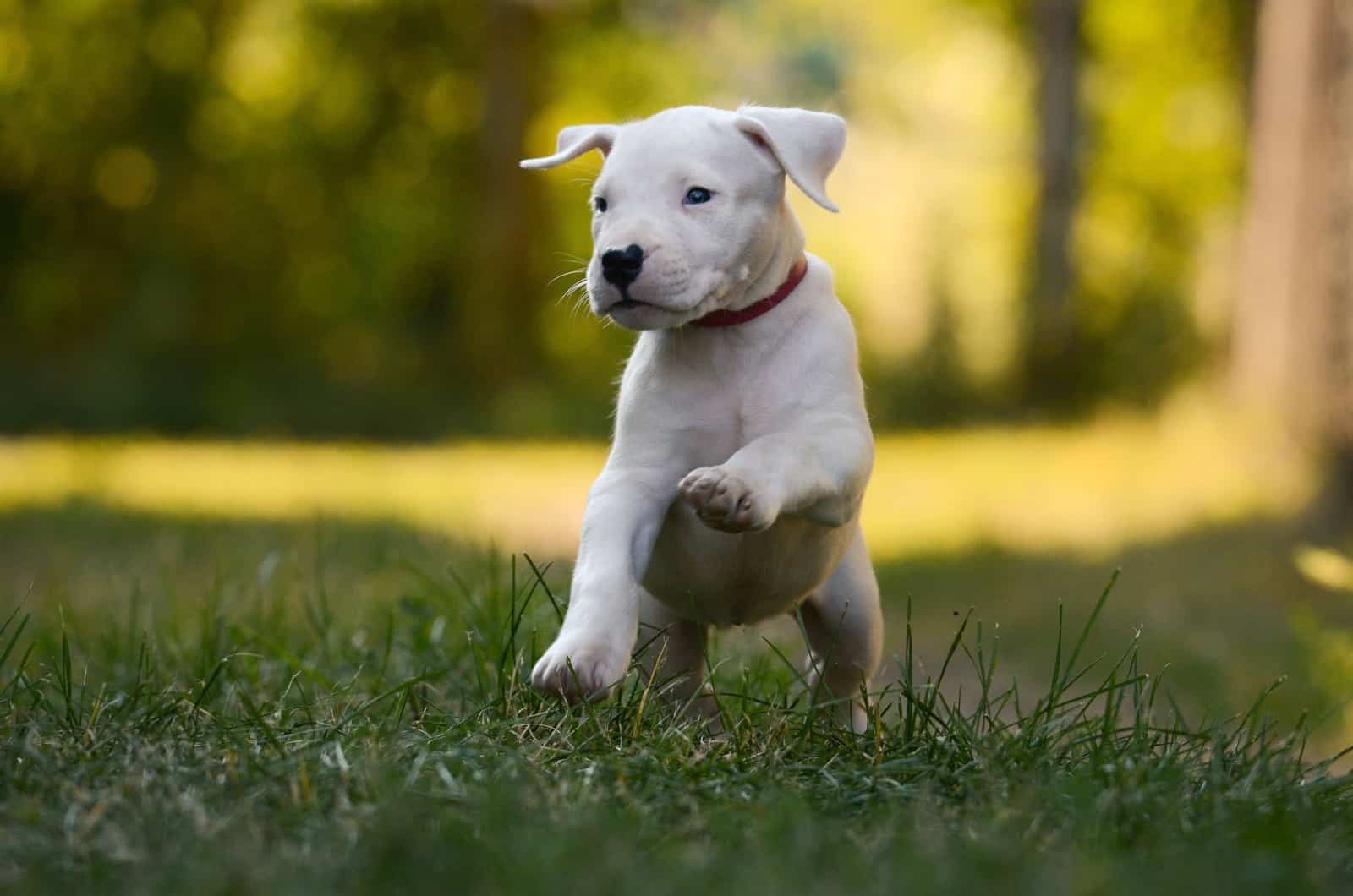
With the Dogo Argentino puppy’s weight chart sorted out, it’s time to take a look at what your dog’s life looks like for the developmental stages of his puppy period and beyond, and what your role is in this whole process, as well as his breeder’s role.
0-2 Weeks Of Age
When your Dogo Argentino puppy just gets born, it’s the duty of his mother to take care of him while you take care of her and facilitate the optimal conditions in which she may perform her duties in.
This usually only boils down to making her comfortable and providing her with enough food and water to keep her well fed and able to produce enough nutrients to cover for herself and her dear pups.
If one does end up getting rejected by his mom for one reason or another, that’s where you’ll be stepping in for him too.
This process is a bit more hands-on as you’ll have to simulate the feeling of a mother’s love in a sense.
The simplest way to do this is to get a heating pad which mimics the mother dog’s body temperature, and a replacement for the mother’s milk and colostrum to feed him with through a bottle.
If you want to add extra realism and comfort, you can always put down a texture over the pad similar to that of a dog’s fur and something that emulates a heartbeat, usually a ticking clock, underneath the pad.
The latter gives the young pup something relatable to calm him down if he’s having trouble falling asleep or having a restless night in general.
3-8 Weeks Of Age
The period that comes after the neonatal stage where the dog can barely do much of anything, a period where he finally gets introduced to the world around him as he finally opens his eyes and is able to waddle around the place.
It’s the point at which he is at his most impressionable which is why so many breeders use this period to conduct behavioral training and leash training, as well as socialize him with other dogs so he can get an idea of how to play with them properly.
During this period is also where the weaning process starts, one where the dog is taught how to move away from his mother as he’ll be rehomed by the end of this period and having him be needy for her will only lead to trouble and dissatisfied pet parents.
It’s healthy for him, and his mother agrees as well as she too will start making them foster their independence from her.
It starts with getting him off of mother’s milk and putting him on puppy kibble. The process is simple, thankfully, you just have to be a little patient.
3 parts milk or water and 1 part kibble mixed in and softened to make it easier to digest and less likely to be rejected by the pupper.
The ratios would then be gradually shifted in favor of the dry dog food until the liquid is completely out of the equation while the dog chows away at it happily.
Do remember this one as it’ll be really useful if you ever need to switch him off one dog food brand to another, especially when putting him on adult or senior dog food later on in life.
By the end of this period, the breeder performs the final health checks for the dog at the vet, making sure he has all his vaccinations in order and that the dog has undergone the routine deworming treatment.
2-3 Months Of Age
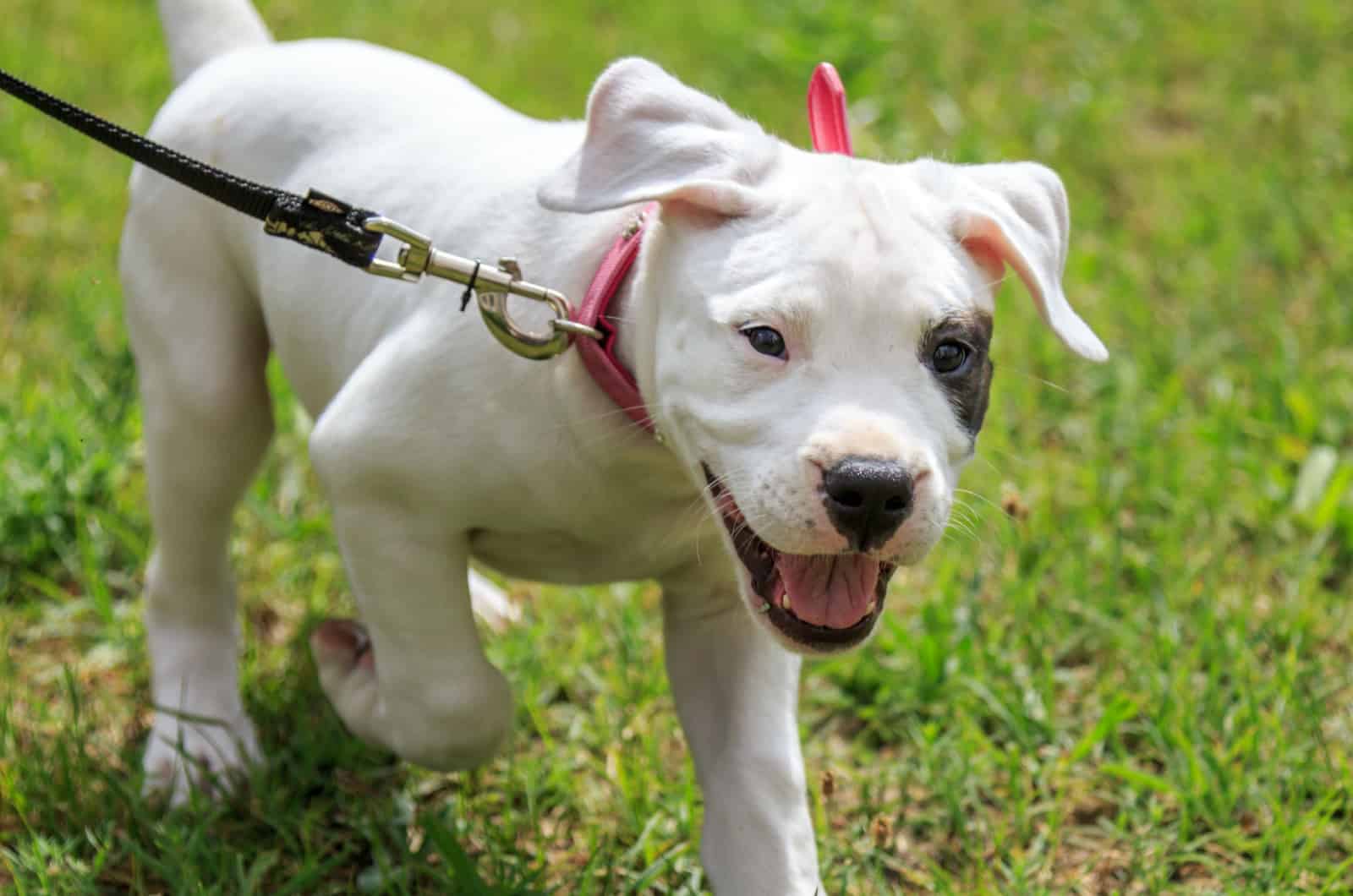
The start of this period is normally the time where the dog gets adopted into a new home and starts his adaptation process with his new family.
By this time, he should have some basic leash and behavioral training as well as having developed some social skills and restraint.
It’s up to his new dog owners now to continue his care and training, especially socialization so he learns how to temper himself around others properly.
For newer dog owners, make sure to ask the breeder what brand of dog food he used to feed him with so you can do the same.
It makes the feeding process a lot easier than having to gradually move him over to a new one through the process mentioned in the earlier period.
4-9 Months Of Age
The most active period of a puppy, one where he acts his age, that of a child who finds everything amusing and wants to try doing absolutely everything now that his body has developed to a more breed-recognizable degree.
He’s gone up a few weight categories by now and has reached a decent height, though the explosive growth rate would be slowing down by the latter half of this period as it reaches the puppy’s adult size.
There’s not much new that’s going to be happening here aside from going through the motions of behavioral training and having to deal with a dog who hits sexual maturity in this period, usually around month 6 or 7, give or take.
It’s when he gets especially unruly and is definitely going to need some of that training to calm himself down in the worst of cases.
If anything, the testosterone in a male dog may make him want to become the ‘leader of the pack’ of the family, but all you need to do is put your foot down and show him who wears the pants around here to earn his obedience there.
If it continues being a problem though, dog owners usually spay or neuter their dogs in this scenario.
However, before doing so, consult with your dog’s vet if that’s the right call as it may interfere with his growth if it hasn’t capped out yet.
10-18 Months Of Age
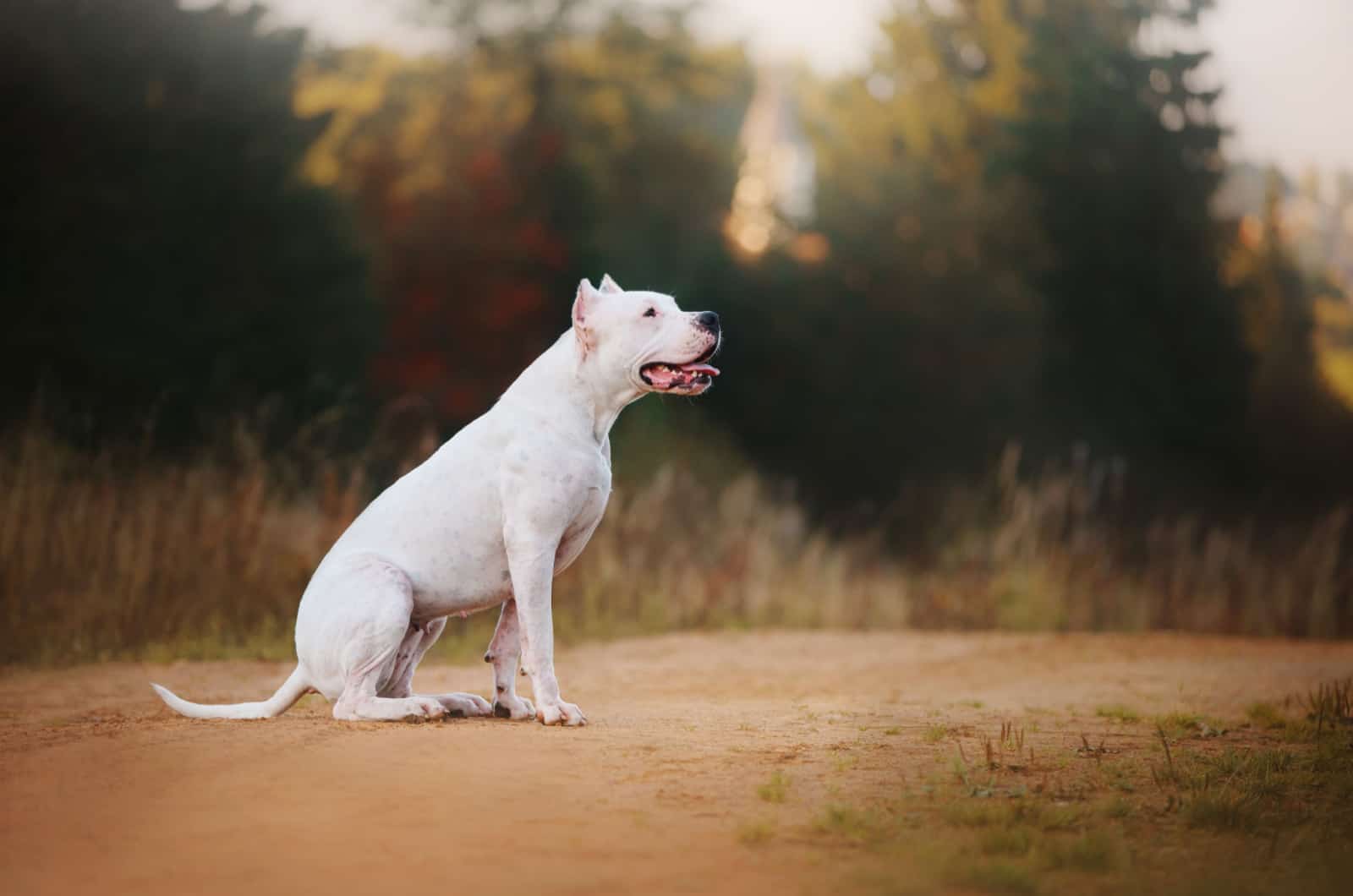
The final stretch before adulthood with a shifting end to the period as some Dogo Argentino are known to become adults a few months prior to month 18 or even later in some cases.
Again, nothing too special will happen here that will require your immediate attention aside from monitoring his weight and height growth and making sure it’s going smoothly.
The one thing you’ll have to do is start getting him used to the less caloric adult dog food over his old puppy kibble, but, once again, it shouldn’t be a problem if you use the trick from earlier.
Adulthood (14-18 Months To 9 Years Of Age)
A Dogo Argentino’s adult life is much like that of any other dog, relatively uneventful in terms of your needed intervention aside from the usual maintenance required through feeding, interaction and exercise.
You’ll be keeping up the same-ish routine until he hits his 9th year of life, at which point he hits his senior years.
There won’t be many changes in height either. As for the weight, that depends on you and what diet you’re keeping your dog on.
Make sure to do a healthy and balanced diet as obesity is no laughing matter for a large dog like the Dogo Argentino.
The amount of food required daily is going to slowly decrease too as his metabolism slows down the closer he gets to the next phase of his life, his senior years.
Senior Years (Year 9 And Onward)
Your dog’s senior years won’t really change that much either apart from swapping from adult food to dog food more oriented toward senior dogs, softer and easier to digest.
He’ll also start becoming more prone to the various health issues that can affect his kind, bloat, as well as bone and joint problems being one of the more common ones for dogs of his size.
Just make sure he can still enjoy himself and that he still gets his exercise in to get the most out of his remaining lifespan.
How Big Do Dogo Argentinos Get?
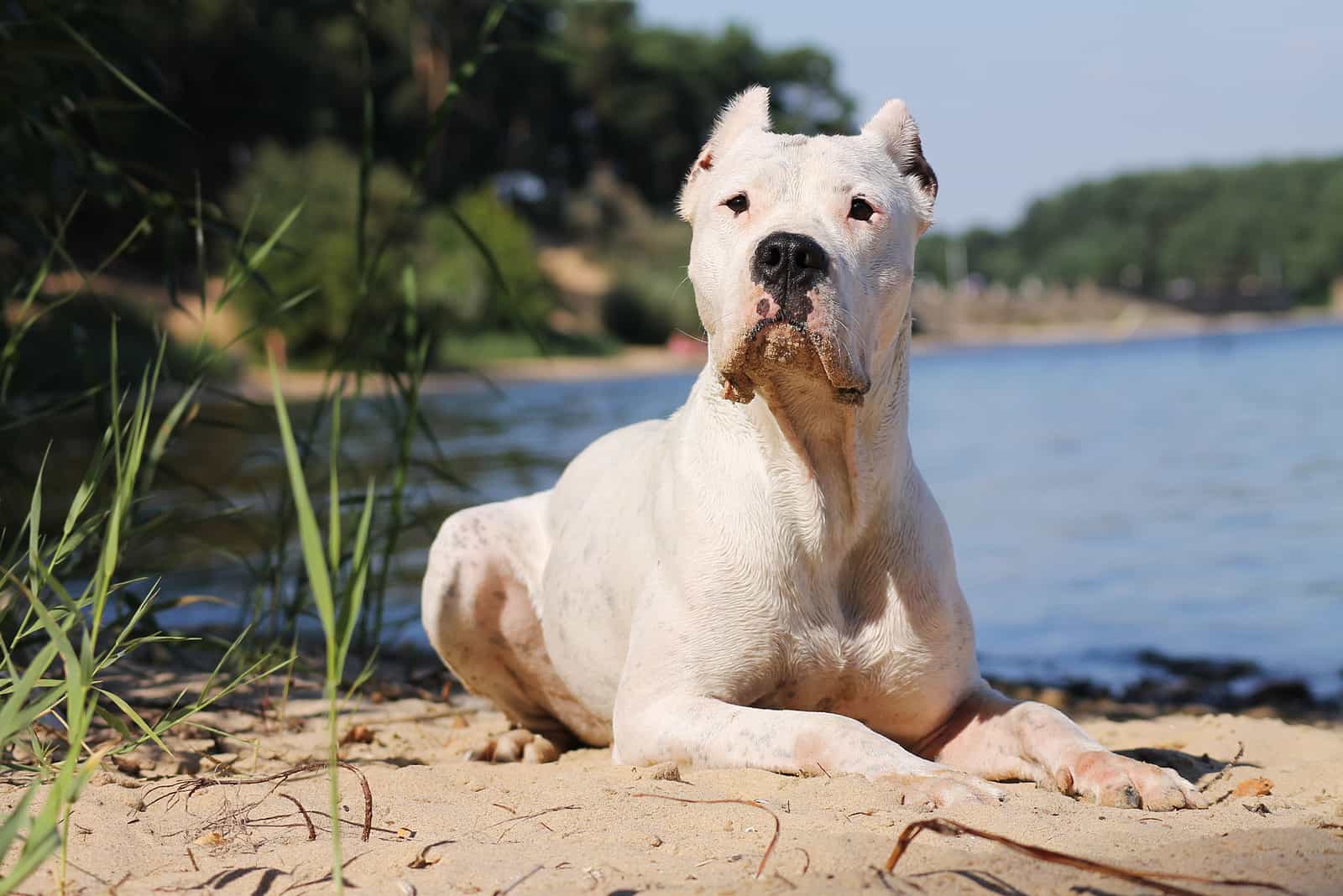
The Dogo Argentino is known as one of the biggest dogs, height wise at least.
They can reach a sizable 27 inches height-wise and put on a maximum weight of around 100 pounds of weight on their bones, at least as far as males are concerned.
For female Dogo Argentino, the numbers are smaller, albeit by an inch and a few pounds with 26 inches and 95 pounds being their average.
Obviously, these numbers can fluctuate, but this is considered to be the standard.
They’ll attain their full form at around month 14 to 18 depending on a few factors, but they shouldn’t veer off that path too much.
The height usually comes in first, having a relatively rapid growth rate up until the 8th month after which the process swaps over to bulking, focusing more on building muscle mass to support his new adult body and reaching his adult weight by the 18th month.
As far as mental maturity is concerned, that one is a bit trickier.
Some Dogo Argentino reach mental maturity at the same time as they become adults, but some continue to be playful and retain parts of their puppy behavior until they’re 2 years old.
While it’s not too harmful, you should be wary as it may mean that your dog may not want to listen to you at times. Make sure to take the necessary measures to prevent that from happening.
What Can Affect My Dog’s Growth?
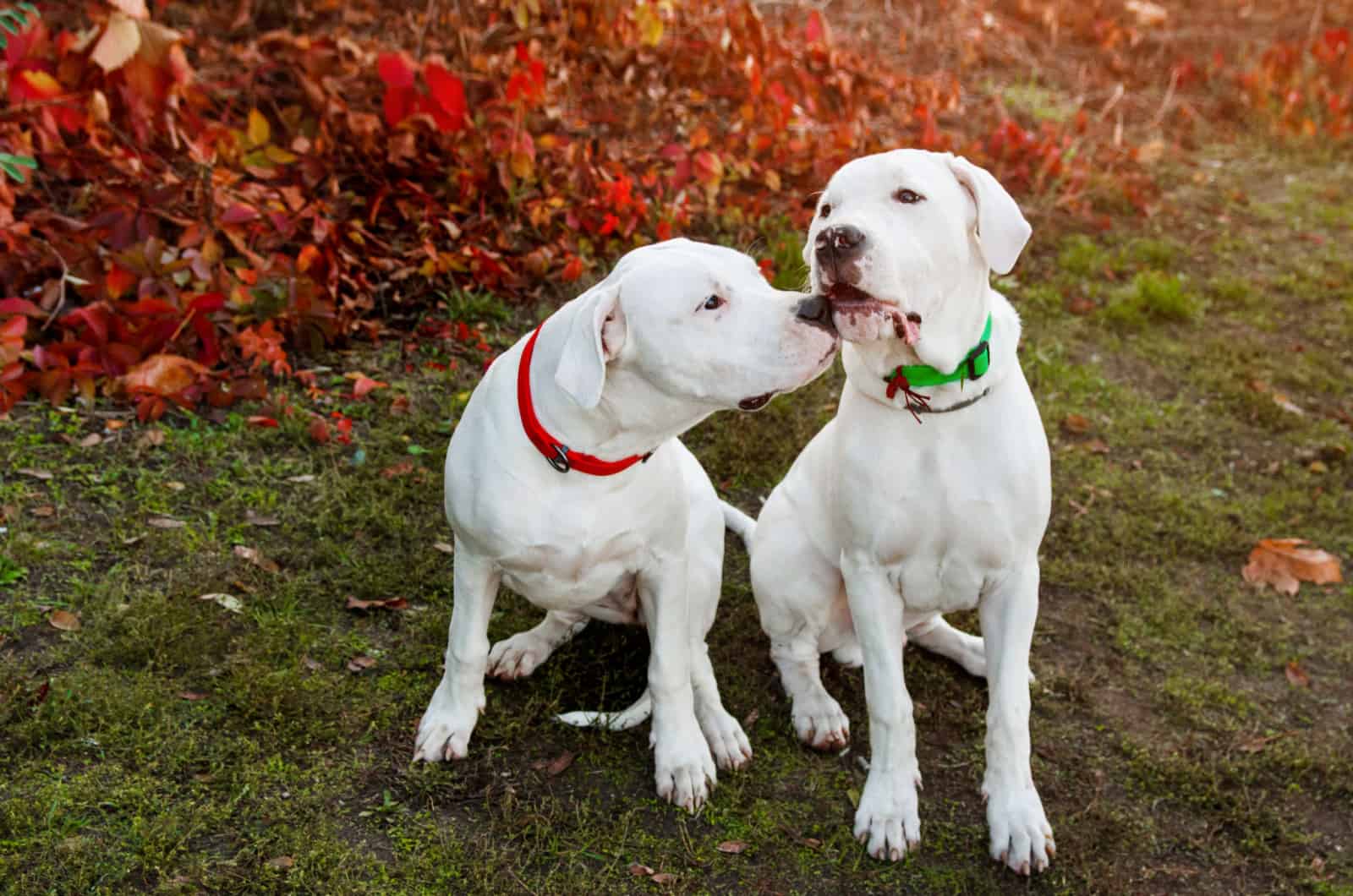
There are three main factors which can greatly affect your dog’s overall growth, genetics, amount of daily exercise, and the amount of health issues they have to contend with.
While the Dogo Argentino is a relatively healthy dog breed, he’s not immune to any of these problems.
Coming out on top against all three of these is what’s required to help keep your dog at his ideal weight and help him keep on track with his overall growth.
Here’s how each one affects him and alters the Dogo Argentino weight chart:
The Genetics
The primary culprit of everything good and bad that happens to a being’s body, be it human, canine or otherwise.
Genetics control everything from hair color, overall growth, behavior and even the body’s level of immunity against disease, allergies and the like.
You get the idea, and it’s the same for dogs too.
Most of his genes will be inherited from his parents. If his parents were bulkier, he’ll have a strong predisposition to become naturally bulky too, albeit some of that can be altered through exercise and other lifestyle changes.
Every doggo has a different set of genes, a hand they’re dealt that they have to play to the best of their ability for the rest of their lives, much like everyone else.
Obviously, genetic predispositions can be either bad or good, the latter doesn’t need any changing and the former can’t always be changed, but some can.
Just make sure to figure out what these genetic issues may be and how to mitigate their effects on your canine companion before they cause him more problems.
His Food Intake
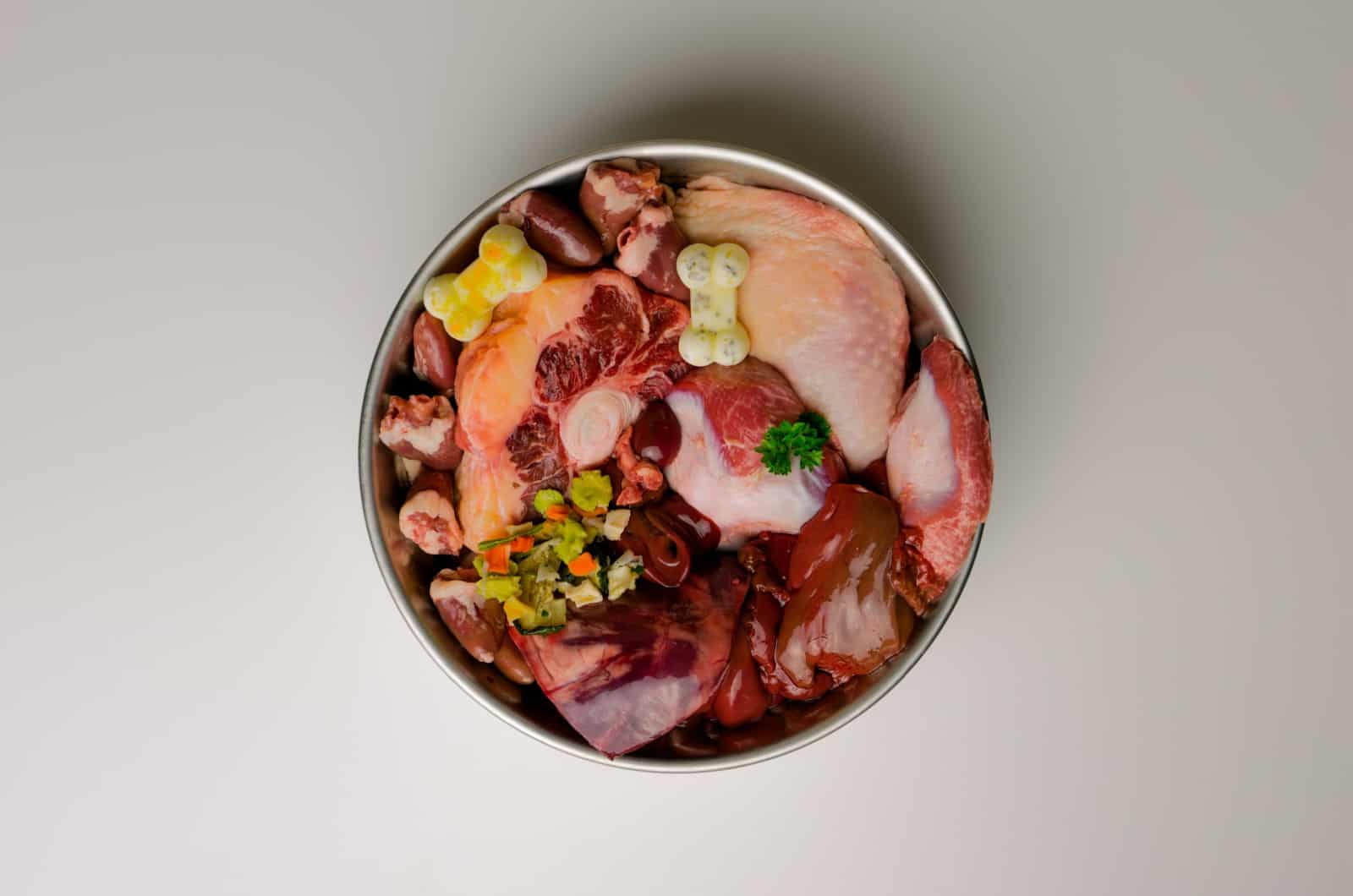
Weight gain through bad food practices can be a big problem, especially if it ends up leading to obesity which can be tough to deal with.
While not as big of a deal as it would be in smaller breeds, entering obesity territory is going to have a large detriment on your dog’s activity levels and may end up making him more prone to heart disease and cause him to exercise less.
On the other hand, a malnourished dog is even worse, so make sure to always feed him a solid diet.
Underfed dogs won’t have enough nutrients to facilitate proper growth and may lead to abnormalities in development.
Proper dieting requires some research though and the best source for it will come from your dog’s vet or pet nutritionist, or their breeder.
Consult with them on what your dog should be fed and how much exactly he should be eating per day.
Use the weight chart as a reference too so you can know what the acceptable weight range is.
Once you find your sweet spot, keep tuning it every now and then to help your Dogo Argentino maintain a healthy weight.
While he’s still a puppy, it’s important to supply him with the best food, one that has a healthy amount of specific nutrients that will allow him to grow into a well developed canine specimen.
The first two things that are of paramount importance for a large dog like the Dogo Argentino are calcium and phosphorus, important building blocks in constructing strong bones and flexible joints to help support your dog’s size.
DHA and EPA are equally as important as they help develop your dog mentally, improving his cognitive function.
Lean protein is key for developing lean muscle mass and shouldn’t be neglected given its importance for your puppy’s growth.
Prebiotic fiber and probiotics are of great importance too to help strengthen his immune system and his gut flora to aid in digestion.
Antioxidants are of equal importance too as they help protect the body from free radicals.
While the Dogo Argentino isn’t the most prone to skin problems, omega-3 and 6 fatty acids are still going to be a welcome addition in helping improve skin quality throughout all stages of his life.
As far as types of dog food, I recommend sticking to dry dog food for the price and nutrition levels alone.
Wet dog food in his adult years can be used as a treat every now and then, but it’s bad for the teeth whereas the dry stuff usually helps clean them somewhat.
His Level Of Exercise
Dogo Argentino usually need a lot of daily exercise to meet their needs given their natural affinity to being large and muscular dogs and desire for physical activity.
Anywhere from an hour to two of moderate exercise should be fine though, but I suggest sticking to the higher threshold personally.
I’d still rather consult your vet on the matter if I were you, especially if your dog has any potential problems relating to his health which may reduce the need for that much exercise in the first place.
Does Neutering Or Spaying My Dog Affect His Growth In Any Way?
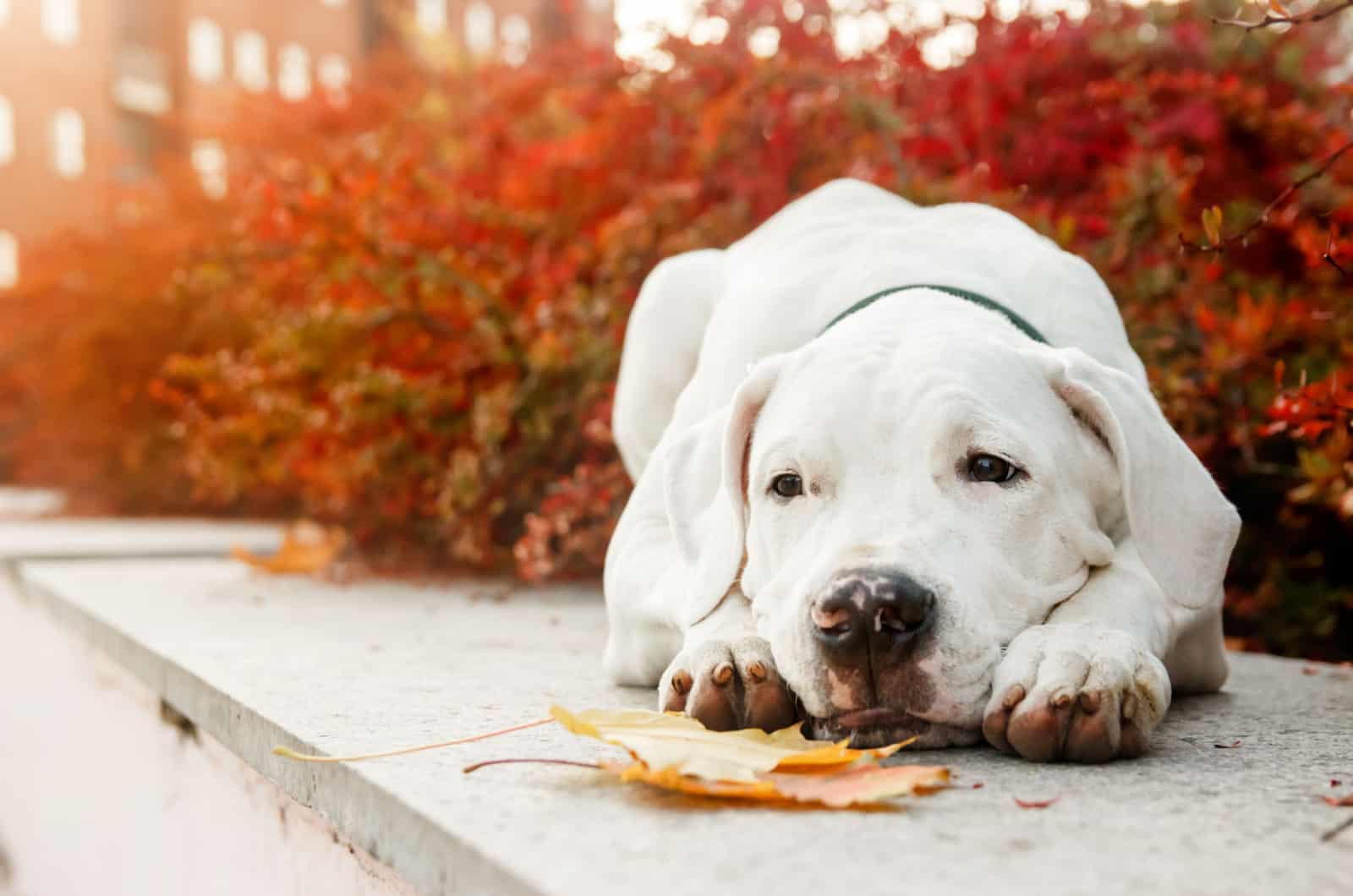
It actually does, if done at an inappropriate time.
If done too early, it can cause various problems with your dog’s overall growth, usually relating to bone growth and skeleton formation.
People usually wait until their dog hits sexual maturity, at which point the skeleton would’ve fully formed and would mark it safe to neuter or spay your dog.
Of course, this isn’t something that’s done so lightly as you should still verify with your dog’s vet as to whether or not it’s safe to perform this procedure or if you should still wait as there’s no de facto way for you to discern this detail at a glance.
Once the procedure is done, he’ll be a lot more docile too if you’ve had issues with him becoming more rebellious once he reached this sexually active period riddled with hormones.
Though, spaying or neutering a dog also has some drawbacks as going through with it may leave your dog more prone to obesity or issues regarding their bones later on in life like elbow and hip dysplasia.
FAQs
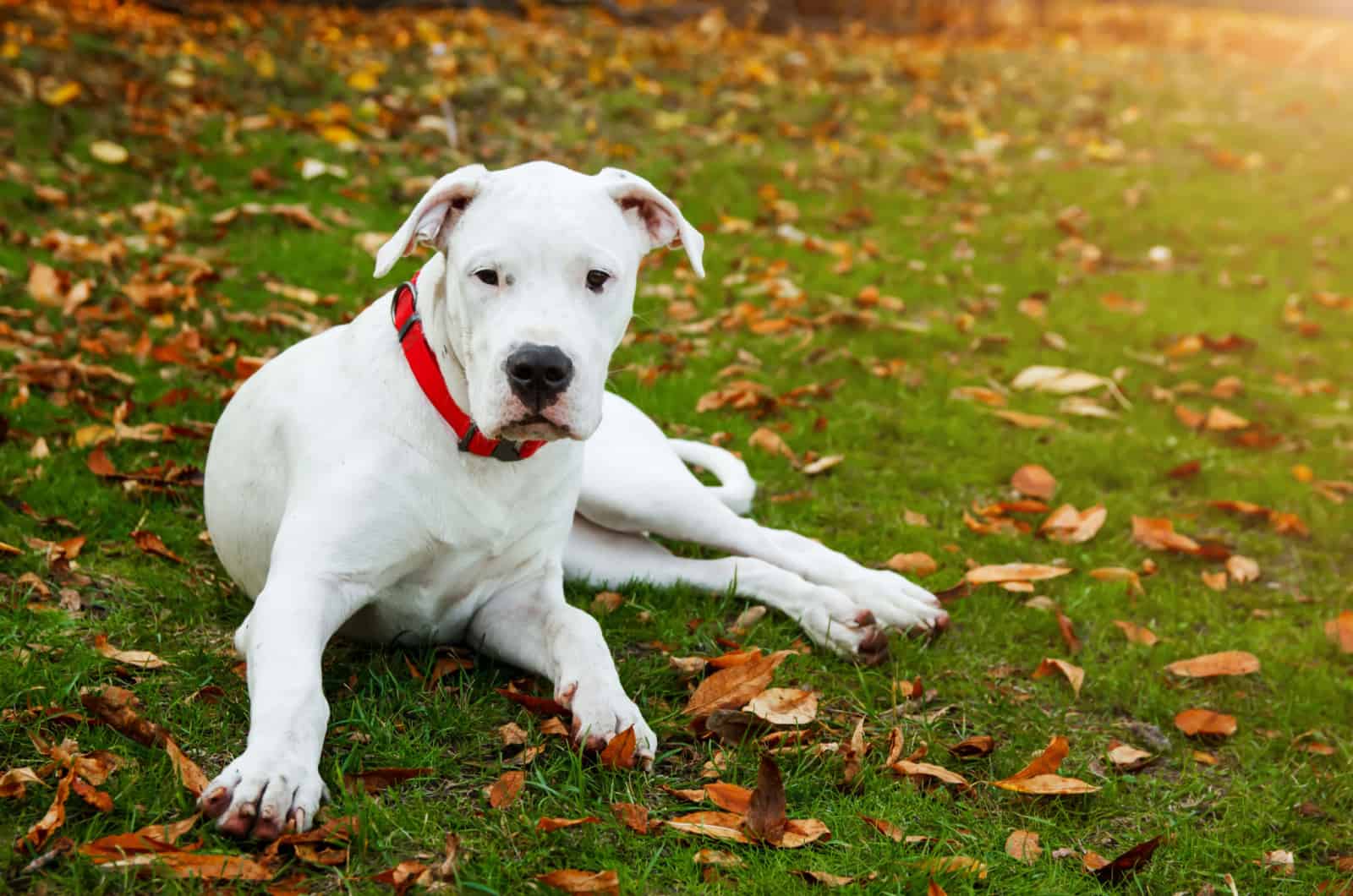
What’s The Average Lifespan Of A Dogo Argentino?
Despite his impressive size, the Dogo Argentino can live a relatively long life thanks to being a naturally healthy dog breed.
While the range is massive, most Dogo Argentino live anywhere from 10 to 15 years depending on how well their owners take care of them.
In an average household, I’d say you can expect him to reach at least 12 or 13 years of age with relative ease.
How Much Does A Dogo Argentino Eat?
Big boys often eat big meals, and it’s no different for the Dogo Argentino.
As a young pup, once he starts to turn toward kibble at around 2 months of age, the average amount usually sits at about 2-3.5 cups of food, spread out through smaller meals.
Most people go with 3 meals a day, but you can do more and smaller portions too if you want to teach him how to pace himself when eating and to prevent future issues with bloat.
As he grows older, the food amount will increase and the amount of meals will lessen, capping out at about 4-5 cups of dry dog food a day when he reaches month 6.
This measurement is kept up to the middle of his adult years, after which the food amount keeps regressing again, though the number of meals stays the same.
The decrease at the later half of his life stems from a slowing metabolism and is mostly guesswork, but you should be able to adapt easily.
What Are Some Of The More Common Health Issues Regarding The Dogo Argentino?
While this breed is considered to be relatively healthy, they’re still prone to the problems that most large dogs encounter as well as one particular one of their own.
Here are all of the more common ones that you’re the most likely to encounter
Problems With Bones And Joints
A dog’s bones and joints will suffer wear over time, and the bigger and heavier a dog is, the more intense that wear is, so it’s only natural that large dog breeds suffer from these issues the most.
For the Dogo Argentino in particular, it relates to hip and elbow dysplasia.
While there isn’t much you can do to prevent it, you can at least ensure that their diet helps slow this wear down.
Talk to a pet nutritionist or your dog’s vet to see what you can change in said diet to help improve your dog’s bone and joint health.
Deafness
This one may sound weird to you, but due to the Dogo’s natural white pigmentation, they’re more prone to suffering from deafness, either partial or full, than most other dogs.
It’s a tragic and harsh problem which you can’t really do much about other than help accommodate him to the best of your ability should it happen to him.
Thankfully, this usually only happens when he’s older, so he’ll get to enjoy life for a good portion of it before this issue potentially occurs.
A staggering 10% of reported Dogo Argentino suffer from deafness as well, which is an astonishingly shocking number.
Bloat
An issue that’s more common in dogs with a deeper chest and large dogs, both boxes which the Dogo Argentino ticks, you can bet that it’s something that comes up often.
A problem that occurs when the stomach distends either from overeating or other causes and then contracts back in such a way that it tangles itself up and ends up trapping the fluid, gas or food within while cutting off the blood flow to other organs.
You can see why this is a serious issue, one that requires immediate treatment before any further complications stem from it.
This is why portion control is an important method of teaching your precious pooch to pace himself while he’s still young to help minimize the risk of this pesky problem, though it sadly won’t fully eliminate the chances of it happening.
Intestinal Parasites
Intestinal parasites, while a problem that’s easily treated, can wreak havoc in the time they’re still inside the body as they’re usually hard to uncover before they start doing damage.
They get into the digestive system of their host, your dog in this case, and nestle on inside. Once situated, they drain the nutrients from the food he ingests, leaving very little for his body, if any, for it to absorb.
This often leads to malnourishment, or worse, if left untreated.
The most common culprits are tapeworms, hookworms and ringworms, but there are some other variants too.
The most common symptoms are vomiting and diarrhea alongside slowed movement and lack of overall energy and will to do much of anything.
The problems that they can cause while your dog is still a pup can, however, be incredibly disastrous as it may interfere with his natural growth cycle and lead to different abnormalities.
This is why every vet and breeder always recommends doing regular stool sample tests for worms, about every 2 months or so, just in case, even if none of the symptoms show up or the previous test turned out negative.
Should it turn out positive, make sure to get your dog signed up for a deworming treatment so the problem can be resolved quickly and so he can return to being your lovable and energetic dog.
What Can I Do If My Dog Is Under Or Overweight?
While certainly not an ideal position to be put in, there are plenty of simple things you can do to help get your dog’s weight back to normal.
Do keep in mind, however, that even if your doggo’s weight is off the average range for his age, it still may not mean that he’s obese or malnourished, though he certainly is treading dangerously close to it.
Should you suspect any issues or if you can’t feel his ribs over his chest, get him to a vet to assess the situation if you need to.
Otherwise, be prepared to make a few lifestyle changes for him which are pretty commonplace.
Regardless of his weight, upping his exercise hours will help improve his health, just don’t overdo it.
Swapping out food brands to something healthier will also help as well as reducing and portioning his meals.
Other than that, be sure to check him for any worms in case one has managed to wriggle itself inside and promptly get rid of it.
They’re simple methods, but effective, and that’s what matters.
In Conclusion
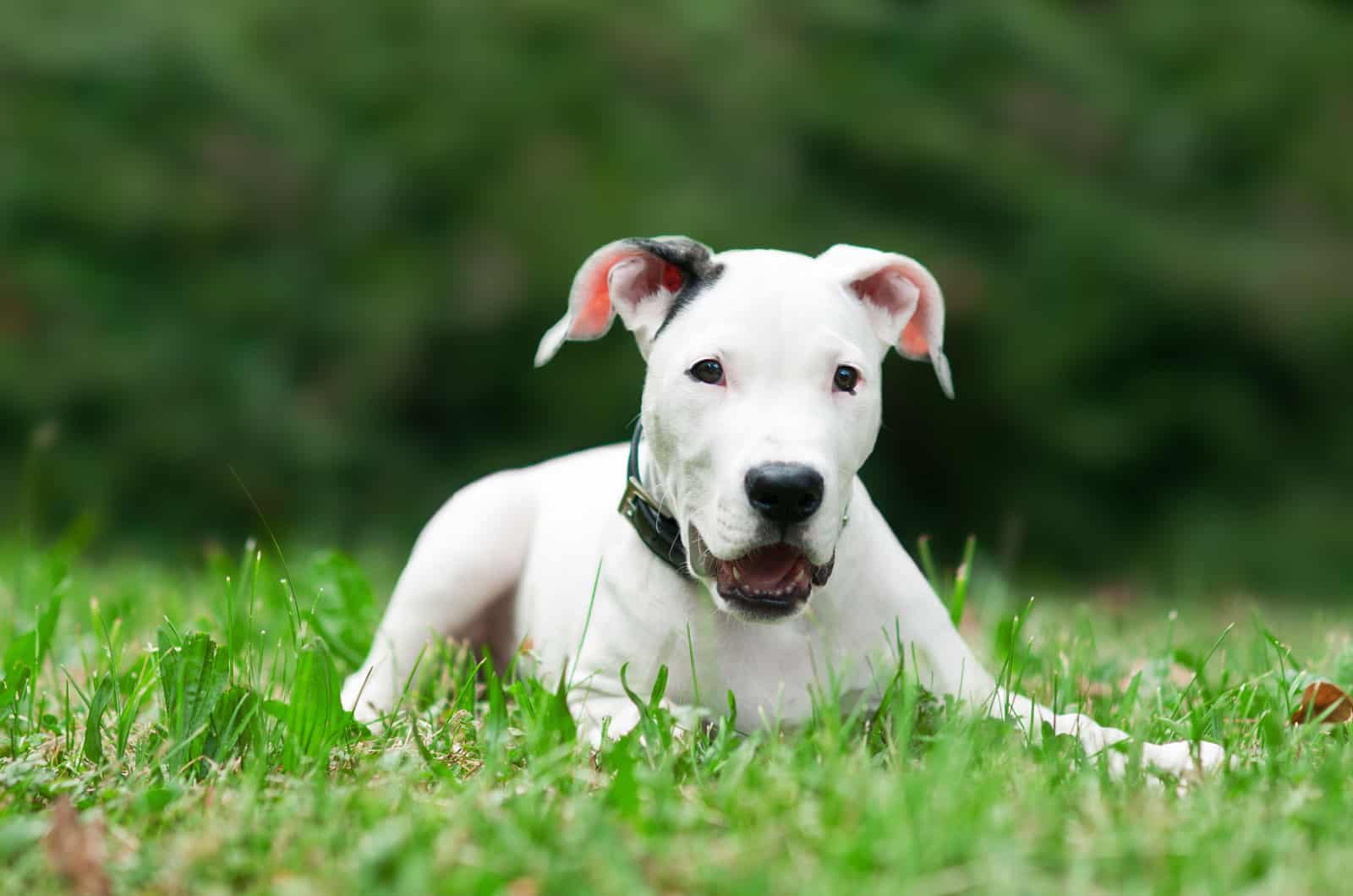
A Dogo Argentino growth chart helps us track the journey of this canine behemoth from when he was a smaller dog, all the way to his prime and his senior years later down the line.
It helps us stay on track with his weight and overall growth and shows us the healthy ranges for both of them.
While it may not look like much, it’s an invaluable tool in allowing Dogo Argentino owners a quick reference they can look back on and use as the building blocks of a healthy diet and a good and long life for their darling doggo.
I hope it manages to do the same for you and your precious pooch.
However, always remember that these numbers are just guidelines and that your dog’s vet has the final say in the matter.
Always ask him about things regarding your dog in particular as he’s the one with more intimate knowledge of him than anyone on the internet possesses so he’ll be able to provide you with the best answers.
I believe that you’ll be able to keep your furry friend healthy and that you’ll do what’s ultimately best for him. Until next time.
RELATED LINKS:
